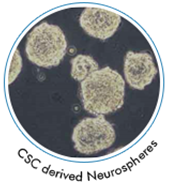 The CSC model postulates that only a fraction of cells within a tumor have the capacity to initiate and sustain tumor growth, and that CSCs must eventually be targeted therapeutically to eliminate tumors and prevent relapse. CSCs (sometimes also referred to as ‘‘tumor-initiating cells’’ or ‘‘cancer-initiating cells’’) share common features with corresponding tissue stem cells, namely their ability to self-renew and give rise to hierarchically organized tissues composed of a variety of cell types. However, CSCs are transformed, express unique markers that allow identification, and are believed to be resistant to many anti-cancer drug regimens.
The CSC model postulates that only a fraction of cells within a tumor have the capacity to initiate and sustain tumor growth, and that CSCs must eventually be targeted therapeutically to eliminate tumors and prevent relapse. CSCs (sometimes also referred to as ‘‘tumor-initiating cells’’ or ‘‘cancer-initiating cells’’) share common features with corresponding tissue stem cells, namely their ability to self-renew and give rise to hierarchically organized tissues composed of a variety of cell types. However, CSCs are transformed, express unique markers that allow identification, and are believed to be resistant to many anti-cancer drug regimens.
“The CSC chemo-resistant phenomenon is” likely a key factor of tumor relapse following therapy. CSCs have recently been verified in vivo and have been demonstrated to exist for tumors initiating from the brain, intestine, skin, and breast. The ability to isolate and phenotype CSCs for drug resistance and susceptibility would facilitate the development of personalized treatment regimens that specifically target CSCs. However, the better drug for targeting CSCs and preventing their re-occurrence is still a mystery. Currently there is not a human, cellular or animal model that represents the genetic diversity of the US population that is diagnosed with cancer. There remains a need to identify novel approaches that improve screening and early detection, as well as reduce the problems of over-diagnosis and over-treatment. A CSC repository that represents the genetic diversity seen in the population that is diagnosed with cancer would introduce a human in vitro model to address the aforementioned needs as well as further basic research involving cancer.
For more information, please contact us at info@jeevan.yagna-tech.com
